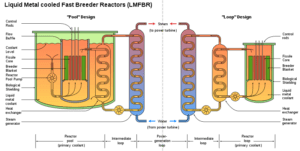Nuclear Energy Renewable or Non-Renewable: Explained
Nuclear energy is non-renewable, because the fuels used to produce this form of energy occur in finite amount. While it is well-known that nuclear energy is an environment-friendly and relatively-efficient option, there are contradicting opinions with respect to the question; is nuclear energy renewable?
This article answers the question, according to the following outline;
-What ‘Renewable Energy’ Means
-Why Nuclear Energy is Viewed as Renewable
-Breeder Reactors and the Question of Renewable Energy
-So, is Nuclear Energy Renewable?
What ‘Renewable Energy’ Means
A good first-step in our efforts to classify nuclear energy as renewable or non-renewable, is to fully understand what the term; ‘Renewable Energy’ actually means.
As the words imply, renewable energy is simply energy which is infinite and continuously replenished.
We may also choose to describe renewable energy as energy that has no limits to its magnitude.
This however does not necessarily mean that the amount of renewable energy available at any point in time will be infinite. It rather means that the source of the energy itself is infinite and continuously replenished (always available in limitless quantity).
We can easily understand this when we consider the sources of solar energy, wave energy and wind energy. While the energy itself might not be generated in infinite amounts at all times, the source of the energy is ever-available.
Based on this understanding, we can further rephrase the definition of nuclear energy, as any form of energy that is generated from an infinite and constantly replenished source.
Why Nuclear Energy is Viewed as Renewable
Now that we have understood what renewable energy means, we can now examine the attributes of nuclear energy and why it is considered by some to be renewable.
Simply put; Nuclear Energy is energy contained in the nucleus of an atom [1].
Although there are various kinds of nuclear reactions which can harvest this energy from the atom, the most commonly used is nuclear fission. This involves the splitting of the atomic nucleus, thereby releasing energy (and creating new atomic entities) in the process [8].
Nuclear energy, which is derived commonly through nuclear fission, is generated in a nuclear reactor. These are complex systems that control the process of nuclear energy production, and help to convert nuclear energy into electricity.
It is widely acknowledged that nuclear energy itself, is very environment-friendly [9]. This implies that it does not release any notable quantities of greenhouse gases into the atmosphere.
However, based on our earlier definition of renewable energy, it is clear that the factor which must be used to categorize nuclear energy as renewable or non-renewable is the source of energy.
The Source of Nuclear Energy
There is a specified class of chemical elements which can be used to achieve nuclear fission and produce nuclear energy. These elements are generally referred to as Radioactive elements, Radioisotopes, or Radionuclides.
Radioactive elements have the unique ability to emit energy in the form of radiation, from their nuclei. This energy may occur in form of heat, and is what is conventionally referred to as nuclear energy.
Examples of radioactive elements include Thorium, Cesium, Carbon, Uranium and Plutonium. Because of their energy-generating potential, these elements are sometimes called ‘nuclear fuels’.
Among these elements however, Uranium is the most commonly-used nuclear fuel. This is because it is very fissile (that is; easily split) and energetic.
A particular isotope of Uranium; U-235, is the most used Uranium isotope as it is the easiest to split [7].
Uranium can be found occurring naturally in the Earth’s crust, in rocks, in concentrations of 2-4 parts per million [11]. It also occurs in seawater.
While it does not usually occur in pure state, Uranium is found in several minerals that include torbernite, carnotite, pitchblende, and autunite. The countries where Uranium is most abundant include Russia, Namibia, Australia, Niger, and Canada.
The Nature of Nuclear Energy
There are various considerations by which we can understand the nature of nuclear energy.
In the world today, nuclear fission constitutes a notable source of power which is used in the generation of electricity.
This process is the mechanism that produces nuclear energy, and it is accountable for about 800 billion kilowatt-hours of electricity per annum in the United States, as well as about 300 billion kilowatt-hours in China and France respectively.
Nuclear energy is characterized by high-density and low carbon-emission, among other attributes.
In a nuclear reactor, the process of producing energy from nuclear fuels is a unique one. It involves bombarding the atoms of the nuclear fuel (which is usually U-235) with high-energy neutron particles [10], such that the nuclei of these atoms are forced to split, releasing nuclear energy as a result.
The atoms which have already been split, produce new atomic elements like Xenon, as well as subatomic particles like neutrons.
These new atomic and subatomic products (also called ‘fission products’) continue to collide and react with each other, in such a manner that makes the production of nuclear energy in the system to be continuous and spontaneous.
Nuclear energy from fission is usually released in the form of heat. This heat is applied to water in a reactor vessel, heating it to produce steam, which is in turn used to drive a steam turbine (or a system of turbines), thereby generating electricity.
The steam used to drive the turbines is itself recycled, by passing it through a condenser (called a cooling tower) which cools it with the help of cold seawater. After it has condensed, the water is recycled; that is; circulated back into the system (to replenish the system) through the reactor vessel.
This makes the overall process of generating nuclear energy and electricity in the reactor system, to be continuous.
Breeder Reactors and the Question of Renewable Energy
Breeder reactors are simply a type of nuclear reactor, which is designed in such a manner as to replenish the nuclear fuel in the system, and continuously produce nuclear energy [6].
This is possible because breeder reactors are capable of producing fissile elements in larger amounts than that which they consume.
These fissile elements (or fission products) are derived when the atomic nuclei of the initial nuclear fuels (which were originally fed into the reactor), are split.
By producing large amounts of fissile elements, breeder reactors ensure that the supply of fuel to the nuclear reactor is extended. By this means, the process of generating nuclear energy becomes more sustainable and continuous.
Breeder reactors have several advantages over normal nuclear reactors. Asides their ability to make nuclear fuels more sustainable, these machines are less-selective than conventional nuclear reactors. This is because breeder reactors do not require only Uranium 235 as nuclear fuel in order to operate, but rather, can run on other fuels like Uranium 238 (U-238) and Thorium 232 (Th-232).
By using U-238, breeder reactors create an avenue to access larger quantities of nuclear fuel to produce energy, as U-238 is much more abundant in nature than U-235 isotope.
Breeder reactors can produce fissile fuel product U-233 from Thorium (Th-232) [2] in the process of generating nuclear energy.
Because of the unique ability of these machines to produce more fuel than they consume, they have served as a strong point for the proponents of the ideology that nuclear energy is renewable. The development of more efficient and sustainable nuclear technologies has only been hampered by the growing threat of the development and proliferation of nuclear weapons.

So, is Nuclear Energy Renewable?
As remarked in the foregoing section, the ability of breeder reactors is one of the most significant pointers to the possibility that nuclear energy may be renewable.
The fuel-breeding ratio of these machines is often up to (or more than) 1.0, and it is believed that breeder reactors can continuously replenish the limited, available nuclear fuel on Earth, simply by converting this fuel into fissile Uranium and Plutonium isotopes.
We must also consider the fact that breeder reactors make use of Uranium-238, which is a much more abundant isotope than Uranium-235 (and is harder to split). In the process of generating nuclear energy through fission reactions, fissile isotopes such as Uranium-233 are produced in large quantity, which is then re-used as fuel for further energy-generation.
Bernard Cohen; a Professor of Physics (1924-2012), in 1983, estimated that by the use of fast breeder reactors, nuclear energy can be generated for billions of years. This estimate was based on the approximate volume of Uranium on Earth (both in the crust and in oceans), and a rate of usage of 6500 tons/year [3].
Based on these projections and others, the Brundtland Report released by the World Commission on Environment and Development (WCED) in 1987, stated that Nuclear Energy as generated by Breeder Reactors, is renewable [4]. This statement was made within the context of the introduction of the sustainable development concept. It was thereby implied that nuclear energy (from breeder reactors) is a useful method in the efforts to achieve sustainability.
So far, it has been made clear that the conventional form or mechanism of nuclear energy generation is not renewable. We must recall at this point, that the process of generating nuclear energy in a convention nuclear reactor involves a continuous mechanism by which steam is recycled and used to replenish the system and produce electricity.
It is also necessary to notice that the words; continuous, recycle, sustainable and replenish, are very often used when describing renewable energy. However, in spite of these terms, conventional nuclear fission is not considered to be a means of generating a renewable energy.
This brings is back to the concept of energy Source. While the mechanism by which energy is produced may be renewable (that is; continuous and self-driven), the main factor which determines whether energy is renewable or not, is the Source of energy.
Nuclear energy is environment-friendly and sustainable– at least with regards to greenhouse emissions [5], at least in comparison to other forms of energy. But is it indeed Renewable?
The opinion that breeder reactors produce renewable nuclear energy is arguable and understandable. From the perspective of energy source, it can be said that; by the use of breeder reactors, nuclear fuels become very abundant, even enough to last for billions of years.
These fuels are recycled and used to produce more fuel by the process of nuclear fission, providing the reactor with more than enough fuel to produce energy.
However, this does not erase the fact that nuclear fuels themselves are naturally-occurring elements, which need to be recovered, from rocks or seawater. They occur in finite, limited quantity on Earth, and can eventually be exhausted.
What this implies is that nuclear energy is not, by its nature and source; renewable. It is rather a non-renewable form of energy, simply because the elements which produce it, are not renewable and can be exhausted.
Nuclear energy is nevertheless important. With the existence of breeder reactors, there are prospects of nuclear energy becoming a very stable, sustainable and reliable form of energy on Earth. It only needs to be supported by developing and improving on renewable energy technologies like wind, geothermal and solar. An approach such as this will be more helpful to ensure a sustainable future.
Conclusion
Nuclear energy is a reliable and environment-friendly option when compared with most of the common forms of energy used in our society today.
The question of whether this form of energy is renewable or not, has been inspired by different factors. One of such factors is the mechanism by which nuclear energy is produced in a reactor. This process is a fairly self-driven and continuous one, which can go unmanned for long periods of time.
Another factor is the existence and operation of a type of nuclear reactors called breeder reactors, which basically create more nuclear fuel than they consume, thereby making the energy-generation process to be prolonged, by continuously replenishing the energy source.
Because of these breeder reactors, nuclear energy was classified as a renewable form of energy in 1987 by the World Commission on Environment and Development (WCED).
Our main deciding-factor however, is the actual meaning of Renewable Energy, which refers to energy generated from an infinite, renewable, non-exhaustible source. Based on this definition, nuclear energy may be disqualified, considering the finite, exhaustible nature of nuclear fuels. This does not negate the fact that it is reliable and environment-friendly (relatively). It rather implies that more effort is needed to develop and innovate renewable energy technology.
References
1). Afework, B.; Boechler, E.; Campbell, A.; Hanania, J.; Jenden, J.; Lloyd, E.; Stenhouse, K.; Toor, J.; Donev, J. (2021). “Energy from nuclei.” Available at: https://energyeducation.ca/encyclopedia/Energy_from_nuclei. (Accessed 23 January 2022).
2). Baker, G. (2007). “Thorium in Australia.” Available at: https://www.aph.gov.au/About_Parliament/Parliamentary_Departments/Parliamentary_Library/pubs/rp/RP0708/08rp11. (Accessed 23 January 2022).
3). Bernard, C. L. (1983). “Breeder reactors: A renewable energy source” (PDF). American Journal of Physics. 51 (1): 75–76. Available at: https://doi.org/10.1119/1.13440. (Accessed 23 January 2022).
4). Brundtland, Gro Harlem (20 March 1987). “Our Common Future, Chapter 7: Energy: Choices for Environment and Development. From A/42/427. Our Common Future: Report of the World Commission on Environment and Development”. Available at: http://www.un-documents.net/ocf-07.htm. (Accessed 23 January 2022).
5). Carrington, D. (2019). “Nuclear power can be green – but at a price.” Available at: https://www.felsics.com/greenhouse-gas-definition-sources-emission-and-effects/. (Accessed 23 January 2022).
6). Delbert, C. (2021). “China Is Building Two Secret Nuclear Reactors. Scientists Are Worried.” Available at: https://www.popularmechanics.com/science/energy/a36517874/china-mysterious-nuclear-reactors/. (Accessed 23 January 2022).
7). EIA (2021). “Nuclear explained: The nuclear fuel cycle.” Available at: https://www.eia.gov/energyexplained/nuclear/the-nuclear-fuel-cycle.php. (Accessed 23 January 2022).
8). Galindo, A. (2021). “What is Nuclear Energy? The Science of Nuclear Power.” Available at: https://www.iaea.org/newscenter/news/what-is-nuclear-energy-the-science-of-nuclear-power. (Accessed 23 January 2022).
9). Phlegar, I. V. (2022). “Nuclear Energy 101: What Is It—and How Could It Benefit the Planet?” Available at: https://brightly.eco/nuclear-energy-environmental-impact/. (Accessed 23 January 2022).
10). Spyrou, A.; and Mittig, W. (2017). “The Science Behind the First Nuclear Chain Reaction, Which Ushered in the Atomic Age 75 Years Ago.” Available at: https://www.smithsonianmag.com/innovation/the-science-behind-first-nuclear-chain-reaction-180967375/. (Accessed 23 January 2022).
11). WNA (2021). “What is Uranium? How Does it Work?” Available at: http://www.world-nuclear.org/information-library/nuclear-fuel-cycle/introduction/what-is-uranium-how-does-it-work.aspx. (Accessed 23 January 2022).


